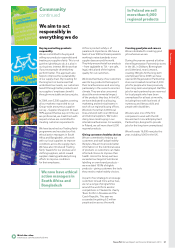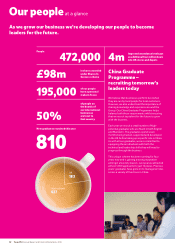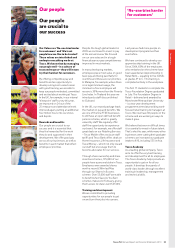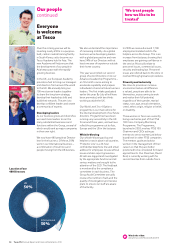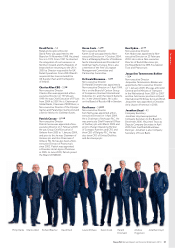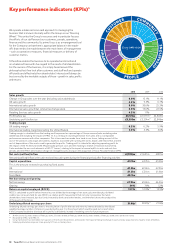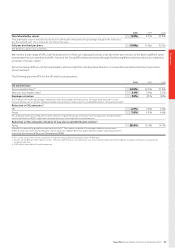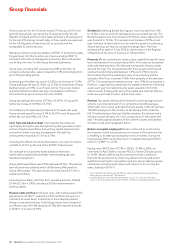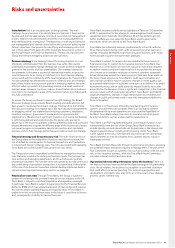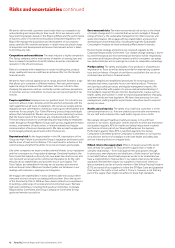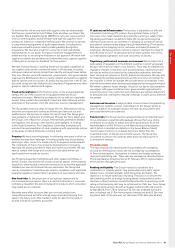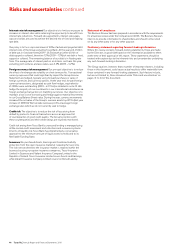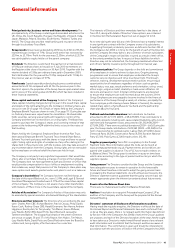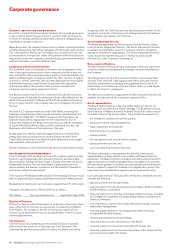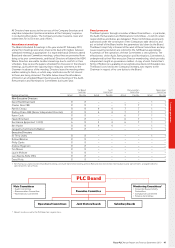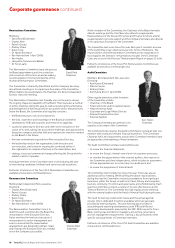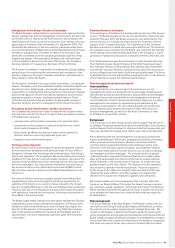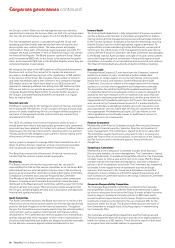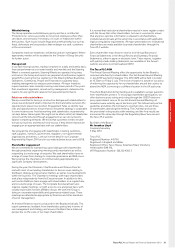Tesco 2010 Annual Report Download - page 43
Download and view the complete annual report
Please find page 43 of the 2010 Tesco annual report below. You can navigate through the pages in the report by either clicking on the pages listed below, or by using the keyword search tool below to find specific information within the annual report.
Tesco PLC Annual Report and Financial Statements 2010 41
Our business
Risks and uncertainties
Introduction Risk is an accepted part of doing business. The real
challenge for any business is to identify the principal risks it faces and to
develop and monitor appropriate controls. A successful risk management
process balances risks and rewards and relies on a sound judgement of
their likelihood and consequence. The Board has overall responsibility for
risk management and internal control within the context of achieving the
Group’s objectives. Our process for identifying and managing risks is set
out in more detail from page 49 of the Corporate Governance section of
the Annual Report and Financial Statements. The key risks faced by the
Group and relevant mitigating factors are set out below.
Business strategy If our strategy follows the wrong direction or is not
effectively communicated then the business may suffer. We need to
understand and properly manage strategic risk in order to deliver long-term
growth for the benefit of all our stakeholders. Our strategy is based on
five elements: to become a successful international retailer, to grow the
core UK business, be as strong in non-food as in food, develop retailing
services and put the community at the heart of what we do. Pursuit of this
five-part strategy has allowed the business to diversify and, at a strategic
level, diversification and pursuit of growth in emerging markets have the
effect of reducing overall risk by avoiding reliance on a small number of
business areas. However, by its very nature, diversification also introduces
new risks to be managed in areas of the business that are less mature and
less fully understood.
To ensure the Group continues to pursue the right strategy, the Board
discusses strategic issues at every Board meeting and dedicates two full
days a year to reviewing the Group’s strategy. The Executive Committee
also discusses strategy on a regular basis. We have structured programmes
for engaging with all our stakeholders including customers, employees,
investors, suppliers, government, media and non-governmental
organisations. We also invest significant resources in ensuring our strategy
is communicated well and understood by the parties who are key to
delivering it. The business operates a Steering Wheel (a balanced scorecard
process whereby we set goals for different areas of the business and assess
our overall progress on a quarterly basis) in all countries and significant
business units to help manage performance and deliver business strategy.
Financial strategy and Group treasury risk The main financial risks of
the Group relate to the availability of funds to meet business needs, the
risk of default by counterparties to financial transactions and fluctuations
in interest and foreign exchange rates. The risks associated with operating
Tesco Bank are covered under Financial services risks below.
The Treasury function is mandated by the Board to manage the financial
risks that arise in relation to underlying business needs. The function has
clear policies and operating parameters, and its activities are routinely
reviewed and audited. The function does not operate as a profit centre and
the undertaking of speculative transactions is not permitted. A description
of the role of the Finance Committee, Internal Audit and External Audit is
set out in the Corporate Governance section on page 50.
Financial services risks Through Tesco Bank, the Group is subject to
certain risks relating to the personal financial services industry in the UK.
Tesco Bank is subject to significant legislative and regulatory oversight.
In particular, Tesco Bank is subject to supervision by the Financial Services
Authority (FSA) which has substantial powers of intervention and requires
it to satisfy certain capital adequacy and liquidity ratios. If Tesco Bank is
unable to or fails to satisfy these ratios in the future it could lose its licence
and, consequently, its ability to transact business.
Tesco Bank became a wholly owned subsidiary of Tesco on 19 December
2008. In preparation for this change its risk management and treasury
capabilities were materially strengthened. All policies pertaining to risk
within the Bank are now subject to Tesco Bank specific governance
procedures which are owned by the Tesco Bank Board.
Tesco Bank has a banking business, predominantly in the UK, with the
three main products being credit cards, unsecured personal loans and
savings. It has also developed a significant insurance business, with motor,
home and pet insurance being the main products.
Tesco Bank is subject to various risks associated with the provision of
financial services. In relation to its insurance business Tesco Bank may
experience a concentration of risks from natural or man-made disasters.
In addition market conditions may not allow it to purchase the amount
of re-insurance it considers necessary on terms it considers acceptable.
Actual claims may exceed the claims provisions that have been made on
the basis of past experience. Tesco Bank’s credit card receivables and
personal loan portfolio may be subject to changes in credit quality, due
to a general deterioration in economic conditions or to failures in its credit
assessment process, which could adversely impact its ability to recover
amounts due. Furthermore, there is significant competition in the financial
services industry which could adversely affect Tesco Bank’s profitability.
Legal developments, changes in legal interpretation or precedent and
changes in public policy may result in new risks emerging in addition to
those anticipated.
Tesco Bank is in the process of building new banking and insurance
systems and until these are complete there is an increased element
of operational risk as most operations are outsourced to Royal Bank of
Scotland. Tesco Bank retains the risk to its insurance activities posed
by external factors, such as a large weather-related event.
Tesco Bank is an FSA-regulated entity and so its treasury function is run
independently from the rest of the Group. Tesco Bank’s treasury risks
include liquidity risk and interest rate risk (in particular, in the interest rate
margin realised between lending and borrowing costs). Tesco Bank
is also subject to the risk of unexpected losses arising from operational
failure, whether as a result of human error, systems failures, fraud or
inadequate controls.
Tesco Bank monitors these risks through its governance structures, assessing
any potential impact and action required to manage them. The work of the
Risk Committee focuses on systemic risks such as funding, credit risk and
risks in the insurance business, while the Tesco Bank Audit Committee
considers internal controls and assurance.
Operational threats and performance risk in the business There is a
risk that our business may not deliver the stated strategy in full, particularly
since, like all retailers, the business is susceptible to economic downturn
that could affect consumer spending. The continuing acquisition and
development of property sites also forms an intrinsic part of our strategy
and this carries inherent risks.


